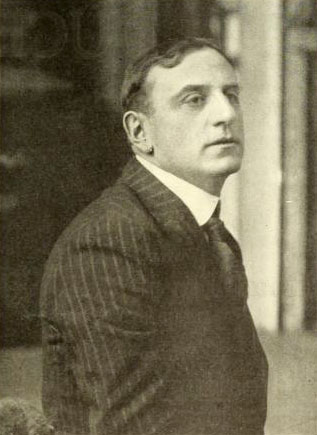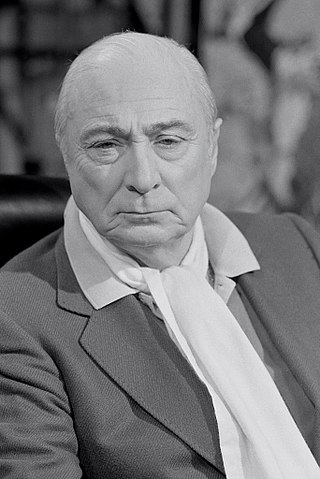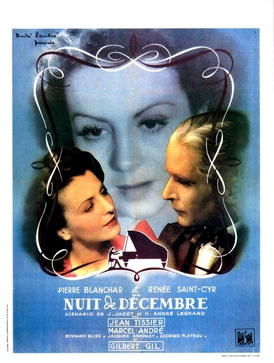
The Arc de Triomphe de l'Étoile, often called simply the Arc de Triomphe, is one of the most famous monuments in Paris, France, standing at the western end of the Champs-Élysées at the centre of Place Charles de Gaulle, formerly named Place de l'Étoile—the étoile or "star" of the juncture formed by its twelve radiating avenues. The location of the arc and the plaza is shared between three arrondissements, 16th, 17th (north), and 8th (east). The Arc de Triomphe honours those who fought and died for France in the French Revolutionary and Napoleonic Wars, with the names of all French victories and generals inscribed on its inner and outer surfaces. Beneath its vault lies the Tomb of the Unknown Soldier from World War I.

Ewald André Dupont was a German film director, one of the pioneers of the German film industry. He was often credited as E. A. Dupont.

Georges Auric was a French composer, born in Lodève, Hérault, France. He was considered one of Les Six, a group of artists informally associated with Jean Cocteau and Erik Satie. Before he turned 20 he had orchestrated and written incidental music for several ballets and stage productions. He also had a long and distinguished career as a film composer.

Abel Gance was a French film director, producer, writer and actor. A pioneer in the theory and practice of montage, he is best known for three major silent films: J'accuse (1919), La Roue (1923), and Napoléon (1927).

Maurice Félix Thomas, known as Maurice Tourneur, was a French film director and screenwriter.

Charles Ferdinand Ramuz was a French-speaking Swiss writer.

Italian futurist cinema was the oldest movement of European avant-garde cinema. Italian futurism, an artistic and social movement, impacted the Italian film industry from 1916 to 1919. It influenced Russian Futurist cinema and German Expressionist cinema. Its cultural importance was considerable and influenced all subsequent avant-gardes, as well as some authors of narrative cinema; its echo expands to the dreamlike visions of some films by Alfred Hitchcock.

Jacques Feyder was a Belgian film director, screenwriter and actor who worked principally in France, but also in the US, Britain and Germany. He was a director of silent films during the 1920s, and in the 1930s he became associated with the style of poetic realism in French cinema. He adopted French nationality in 1928.

Pierre Benoit was a French novelist, screenwriter and member of the Académie française. He is perhaps best known for his second novel L'Atlantide (1919) that has been filmed several times.

Gérard Oury was a French film director, actor and writer.

Marcel L'Herbier was a French filmmaker who achieved prominence as an avant-garde theorist and imaginative practitioner with a series of silent films in the 1920s. His career as a director continued until the 1950s and he made more than 40 feature films in total. During the 1950s and 1960s, he worked on cultural programmes for French television. He also fulfilled many administrative roles in the French film industry, and he was the founder and the first President of the French film school Institut des hautes études cinématographiques (IDHEC).

Augusto Genina was an Italian film pioneer. He was a movie producer and director.
Richard Eichberg was a German film director and producer. He directed 87 films between 1915 and 1949. He also produced 77 films between 1915 and 1950. He was born in Berlin, Germany and died in Munich, West Germany.

Émile Chautard was a French-American film director, actor, and screenwriter, most active in the silent era. He directed more than 100 films between 1910 and 1924. He also appeared in more than 60 films between 1911 and 1934.

Albert Capellani was a French film director and screenwriter of the silent era. He directed films between 1905 and 1922. One of his brothers was the actor-sculptor Paul Capellani, and another, film director Roger Capellani.

Léon Eugène Frapié was a French novelist.

The Girl Who Stayed at Home is a 1919 American silent drama film produced and directed by D. W. Griffith and released by Paramount Pictures. Prints of the film exist.

Curt Courant was a German-American cinematographer whose work includes more than 100 German and international films from the silent and early sound eras. Courant worked in several European countries, collaborating with figures such as Fritz Lang, Alfred Hitchcock and Charlie Chaplin. As he was of Jewish ancestry, Courant was forced to leave Germany in 1933 and go into exile following the Nazi takeover of power.

Night in December is a 1940 French drama film directed by Curtis Bernhardt and starring Pierre Blanchar, Renée Saint-Cyr and Gilbert Gil. It was shot at the Billancourt Studios in Paris. The film's sets were designed by the art directors Henri Ménessier and Jean d'Eaubonne. It was Bernhardt's last French film before he left the country for America. It was given a re-release by DisCina in 1949.
Lucien Henri Nonguet was a French film director, actor and screenwriter. He was one of the first film directors and screenwriters of the Pathé company.



















